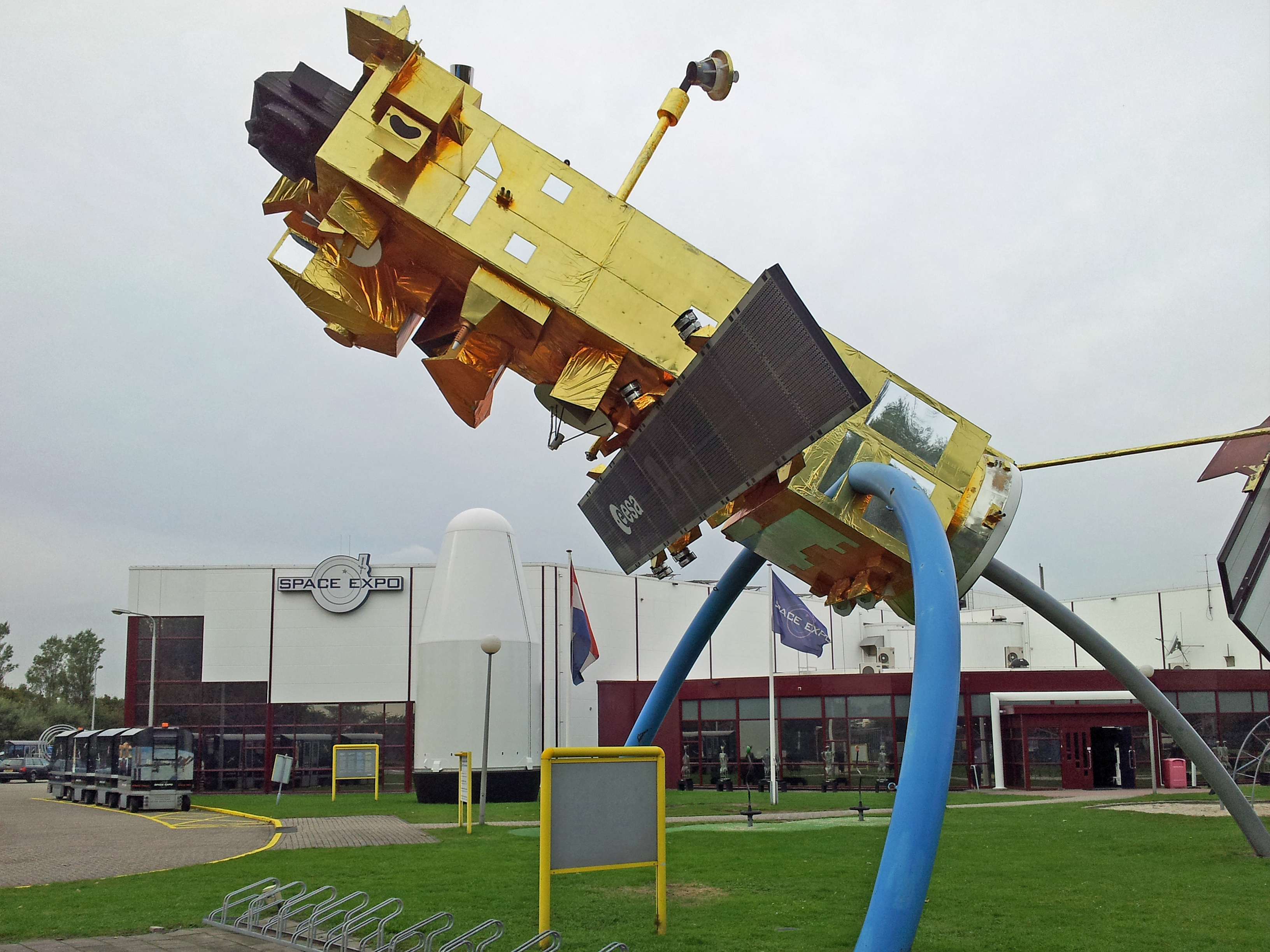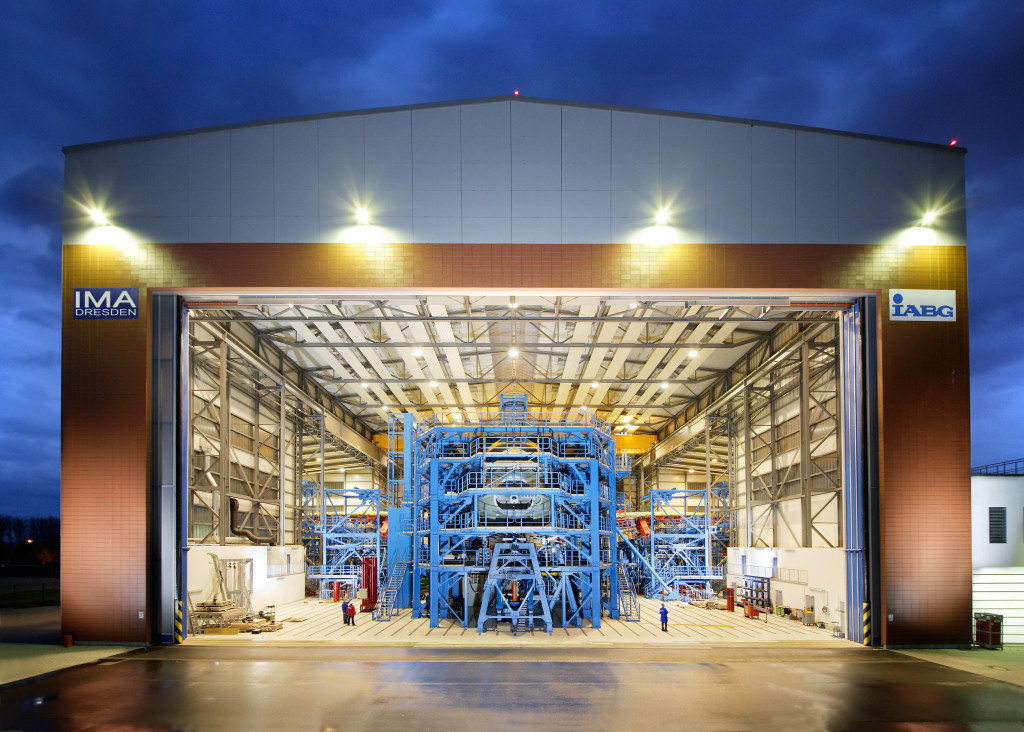|
ESTEC
The European Space Research and Technology Centre (ESTEC) is the European Space Agency's main technology development and test centre for spacecraft and space technology. It is situated in Noordwijk, South Holland, in the western Netherlands, although several kilometers off the village but immediately linked to the most Northern district of the nearby town Katwijk. At ESTEC, about 2500 engineers, technicians and scientists work hands-on with mission design, spacecraft and space technology. ESTEC provides extensive testing facilities to verify the proper operation of spacecraft, such as the Large Space Simulator (LSS), acoustic and electromagnetic testing bays, multi-axis vibration tables and the ESA Propulsion Laboratory (EPL). Prior to launch, all of the equipment that ESA launches is tested in some degree at ESTEC, other than those tested at national space centers of ESA member countries. The Space Expo is ESTEC's visitors centre. It has a permanent exhibition about space explor ... [...More Info...] [...Related Items...] OR: [Wikipedia] [Google] [Baidu] |
ESRO
The European Space Research Organisation (ESRO) was an international organisation founded by 10 European nations with the intention of jointly pursuing scientific research in space. It was founded in 1964. As an organisation ESRO was based on a previously existing international scientific institution, CERN. The ESRO convention, the organisations founding document outlines it as an entity exclusively devoted to scientific pursuits. This was the case for most of its lifetime but in the final years before the formation of ESA, the European Space Agency, ESRO began a programme in the field of telecommunications. Consequently, ESA is not a mainly pure science focused entity but concentrates on telecommunications, earth observation and other application motivated activities. ESRO was merged with ELDO in 1975 to form the European Space Agency. [...More Info...] [...Related Items...] OR: [Wikipedia] [Google] [Baidu] |
European Space Agency
The European Space Agency (ESA) is a 23-member International organization, international organization devoted to space exploration. With its headquarters in Paris and a staff of around 2,547 people globally as of 2023, ESA was founded in 1975 in the context of European integration. Its 2025 annual budget was €7.7 billion. The ESA Human and Robotic Exploration programme includes human spaceflight (mainly through participation in the International Space Station programme); as well as the launch and operation of missions to Mars and Moon. Further activities include science missions to Jupiter, Mercury, the Sun, Earth observation, Asteroid impact avoidance and Telecommunications missions, designing launch vehicles; and maintaining Europe's Spaceport, the Guiana Space Centre at Kourou (French Guiana). Further programmes include space safety, satellite navigation, applications and commercialisation. The main European launch vehicle Ariane 6 is operated through Arianespace ... [...More Info...] [...Related Items...] OR: [Wikipedia] [Google] [Baidu] |
Mission Science Division
The Earth and Mission Science Division is a group of European Space Agency (ESA) staff mission scientists, contractors, research fellows, young graduates, trainees, and administrative staff working within the Climate Action, Sustainability and Science Department of the Directorate of Earth Observation Programmes. The Division is located at ESA's European Space Research and Technology Centre in Noordwijk, South Holland, The Netherlands. Introduction The Earth and Mission Science Division (MSD) supports the preparation, development and operations of research and operational missions within the Earth Observation Programmes Directorate. The Division is responsible for ensuring the application of scientific and other user community requirements in all phases of the development of Earth Observation missions, from precursor studies through to in-orbit satellite operations, and for ensuring coherence throughout with the objectives expressed in the mission requirements documents, includi ... [...More Info...] [...Related Items...] OR: [Wikipedia] [Google] [Baidu] |
IABG
IABG (Industrieanlagen-Betriebsgesellschaft mbH) is a German analysis and test engineering company based in Taufkirchen near Munich. History The company was founded in 1961 on the initiative of the federal government as a central analysis and testing facility for the Federal Ministry of Defence and the aeronautical industry. In 1993, the company was privatized and is now run by its owners. Up to January 1 of 2010, SCHWARZ Holding GmbH (87.4% of the share capital) together with IABG Mitarbeiterbeteiligungs AG (MBAG, 12.6% of the share capital) form the IABG shareholder group. In 2019 IABG employed around 1,000 employees at 12 German and international locations. ;Projects In 1993, IABG started the first large-scale project with the total-cycle fatigue test on the first Airbus model, the Airbus A300. In 1992 major tests began on the European rocket Ariane 5. One of the best-known projects is the total fatigue test on the Airbus A380, which was carried out by the IABG from 2004 t ... [...More Info...] [...Related Items...] OR: [Wikipedia] [Google] [Baidu] |
European Space Operations Centre
The European Space Operations Centre (ESOC) serves as the main mission control centre for the European Space Agency (ESA) and is located in Darmstadt, Germany. ESOC's primary function is the operation of uncrewed spacecraft on behalf of ESA and the launch and early orbit phases (LEOP) of ESA and third-party missions. The Centre is also responsible for a range of operations-related activities within ESA and in cooperation with ESA's industry and international partners, including ground systems engineering, software development, flight dynamics and navigation, development of mission control tools and techniques and space debris studies. ESOC's current major activities comprise operating planetary and solar missions, such as Mars Express and the Trace Gas Orbiter, astronomy & fundamental physics missions, such as Gaia and XMM Newton, and Earth observation missions such as CryoSat2 and Swarm. ESOC is responsible for developing, operating and maintaining ESA's ESTRACK network of ... [...More Info...] [...Related Items...] OR: [Wikipedia] [Google] [Baidu] |
Concurrent Design Facility
The Concurrent Design Facility (CDF) is the European Space Agency main assessment center for future space missions and industrial review. Located at ESTEC, ESA's technical center in Noordwijk in The Netherlands, it has been operational since early 2000. As suggested by its name, the CDF uses concurrent engineering methodology to perform effective, fast and cheap space mission studies. Equipped with a state-of-the-art network of computers, multimedia devices and software tools, the CDF allows teams of experts to perform design studies during working sessions. Activities The CDF is mainly in charge of performing the assessment studies of future missions for the European Space Agency The European Space Agency (ESA) is a 23-member International organization, international organization devoted to space exploration. With its headquarters in Paris and a staff of around 2,547 people globally as of 2023, ESA was founded in 1975 .... These assessment studies are performed in the ... [...More Info...] [...Related Items...] OR: [Wikipedia] [Google] [Baidu] |
Soyuz TMA-03M
Soyuz TMA-03M was a spaceflight to the International Space Station (ISS). It launched on 21 December 2011 from Site One at the Baikonur Cosmodrome, Kazakhstan, carrying three members of Expedition 30 to the ISS. TMA-03M was the 112th flight of a Russian Soyuz spacecraft, since the first in 1967, and the third flight of the modernised Soyuz-TMA-M version. The docking with the International Space Station took place at 19:19 Moscow Time on 23 December, three minutes ahead of schedule.Состоялся запуск транспортного пилотируемого корабля «Союз ТМА-03М» |
International Space Station
The International Space Station (ISS) is a large space station that was Assembly of the International Space Station, assembled and is maintained in low Earth orbit by a collaboration of five space agencies and their contractors: NASA (United States), Roscosmos (Russia), European Space Agency, ESA (Europe), JAXA (Japan), and Canadian Space Agency, CSA (Canada). As the largest space station ever constructed, it primarily serves as a platform for conducting scientific experiments in microgravity and studying the space environment. The station is divided into two main sections: the Russian Orbital Segment (ROS), developed by Roscosmos, and the US Orbital Segment (USOS), built by NASA, ESA, JAXA, and CSA. A striking feature of the ISS is the Integrated Truss Structure, which connect the station’s vast system of solar panels and Spacecraft thermal control, radiators to its pressurized modules. These modules support diverse functions, including scientific research, crew habitation, ... [...More Info...] [...Related Items...] OR: [Wikipedia] [Google] [Baidu] |
Katwijk
Katwijk () is a coastal municipality and town in the province of South Holland, which is situated in the mid-western part of the Netherlands. The Oude Rijn (Utrecht and South Holland), Oude Rijn ("Old Rhine") river flows through the town and into the North Sea. Katwijk is located on the North Sea, northwest of Leiden and 16 km north of The Hague. It shares its borders with the municipalities of Noordwijk, Teylingen, Oegstgeest, Leiden, and Wassenaar. In August 2020, Katwijk had a population of 65,929 and covers an area of , of which is water. Katwijk is by far the largest town in the Duin- en Bollenstreek ("Dune and Bulb Region"). Districts The town consists of a number of districts, including namesakes Katwijk aan den Rijn and Katwijk aan Zee. On 1 January 2005 the various districts had the following populations: :*Katwijk aan den Rijn (5,916) :*Katwijk aan Zee (22,405) :*Katwijk-Noord (13,845) :*Rijnsburg (15,450) :*Valkenburg, South Holland, Valkenburg (3,904) Ly ... [...More Info...] [...Related Items...] OR: [Wikipedia] [Google] [Baidu] |
ESA Centre For Earth Observation
The ESA Centre for Earth Observation (also known as the European Space Research Institute or ESRIN) is a research centre belonging to the European Space Agency (ESA), located in Frascati (Rome) Italy. It is dedicated to research involving earth observation data taken from satellites, among other specialised activities. The establishment currently hosts the European Space Agency's development team for the Vega launcher. History ESLAR, a laboratory for advanced research was created in 1966 mainly to break the political deadlock over the location of ESLAB. Later renamed ESRIN, an acronym for European Space Research Institute, ESLAR was based in Frascati (Italy). The ESRO Convention describes ESRINs' role in the following manner: The facility began acquiring data from environmental satellites within Earthnet programme in the 1970s. See also * European Astronaut Centre (EAC) * European Centre for Space Applications and Telecommunications (ECSAT) * European Space Agency (ESA) ... [...More Info...] [...Related Items...] OR: [Wikipedia] [Google] [Baidu] |





